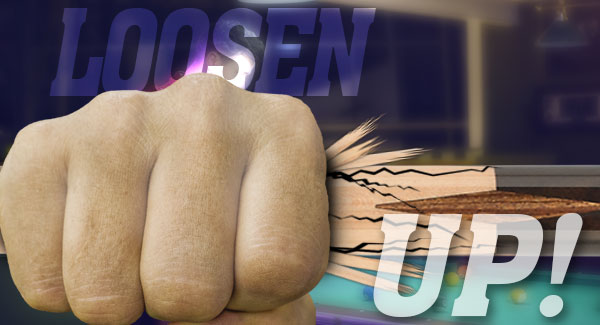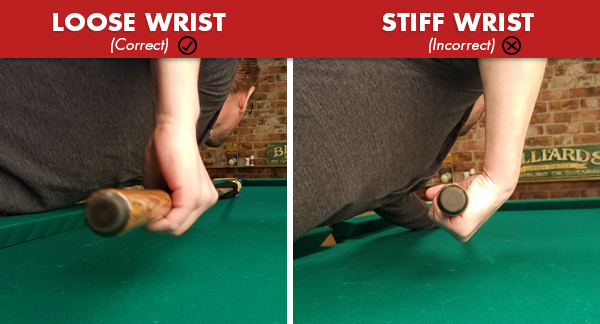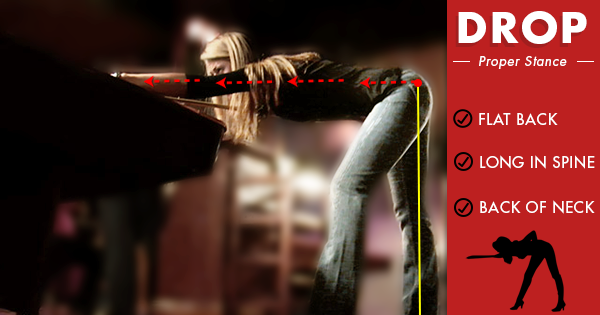
It’s hard to be soft, especially for pool players. We seem to have a need to hit hard. We’ve all heard expressions such as “grip it and rip it” and “force it.” Put a stick in our hand and we want to hit something with it. Our tendency is to over-muscle everything.
Remember a time when you were learning a brand-new skill such as a golf or tennis swing, hammering a nail, or using the brakes while driving a car. Initially we tend to squeeze way too hard, muscle the nail, and slam on the brakes. Over time, as our skills develop, we get softer and lighter. We develop feel and awareness in our hands and our connection to the club, hammer, and brake pedal becomes coordinated and soft.
Whatever the reason, most players hit way too hard. And they pretty much do everything with too much muscle. As we clench things up, our movements become jerky and constricted - not what we need for an athletic activity. However, most of us naturally begin learning skills by somewhat awkwardly muscling through the action. Hopefully, we get past those early efforts and become soft and fluid.
In pool school, we frequently joke that when something is not working well, the answer is, “Hit it harder!” By making this joke, we hope the students get the idea that too much muscle, too much tension, too much fighting yourself, is often our key problem in pool. Smooth is beautiful.
We have many clever and subtle ways of screwing up our game. Physically, anything you clench is connected to other body parts, so your clenches show up as inconsistent results. Imagine riding a bike with one or two sections of the chain rusty and stiff. You’d feel it, and the overall quality of your ride would be affected. Same kind of thing. And it’s not just hitting hard. There are many ways to overdo or constrain aspects of your fundamentals of form. At school, we bring players’ attention to various parts of their bodies that may hold unnecessary, counter-productive tension. Let’s visit a few:
Grip
As you squeeze the cue or rigidify your grip hand, you lose your intuitive connection to the stick. It doesn’t feel like part of your arm. We joke about “white knuckling” and squeezing sap out of the butt of the cue. It’s generally accepted in pool that your grip should be soft, so you can swing fluidly. Are you squeezing the stick? Is there a lot of tension in your grip hand? Are you poking?
 Frank Says: "If you have a tendency to grip too hard, you should check out Stealth Cues! Their patented Dooley Handle is designed to keep your hand loose without sacrificing control."
Frank Says: "If you have a tendency to grip too hard, you should check out Stealth Cues! Their patented Dooley Handle is designed to keep your hand loose without sacrificing control."
Wrist
If your wrist is stiff, your stroke will likely be jerky and stiff looking. Imagine hammering a nail with a stiff wrist. It doesn’t work very well. Does your stroke often finish with your wrist curled? Let your wrist go. Your grip hand should just hang from the wrist and float nicely in response to the swinging motion of your forearm.

Drop
Drop – As you move from standing and go down into your shooting stance and setup, try to feel “large and in charge”. You want your joints to be open so you’re not feeling crunched up. A clue to good body use here is to try to feel tall – long in your spine and the back of your neck. Another powerful indicator of good athleticism is a flat back when you’re down on the shot. Slumping hurts you and yields slumpy results.

Set-Up
Does your stroke style have a full stop at “set” (stop close to cue ball, and decide whether you’re ready to go)? There are many benefits to this, but the danger is losing fluidity when you stop moving. How do you move smoothly from a full stop to pulling the stick back for the hit? The key idea here is to be soft at the beginning of your set-up. Soften your grip, relax your forearm, and ever so softly begin the backswing.
Transition
At the back of the backswing, your stick has to change direction. Many shots are missed due to tension at this moment. If you’re working too hard, the transition is jerky. Now you’ve put a loop on the back of the swing and are coming forward on a new, incorrect line. Be as soft as you can at the transition. Take the stick back smoothly and don’t fight yourself to come forward. Don’t rush it.
Head
A soft head is not the same as “soft in the head.” Where are you carrying tension? Are your teeth clenched? Is your face scrunched up because your eyeglasses are wrong for pool? Is your head moving during your shot? Find a head position where the only thing that moves is your eyeballs. And of course, they don’t move during the hit stroke.
Butt
I’m not talking about the stick here. My belief is most of us are carrying too much clench. Yes, we really are tightasses. While really squeezing your butt, try to bend over, and you’ll see what I’m talking about. I think this has a lot to do with why so many players are unable to bend from the pelvis and shoot with a flat back. Let it go. Now let it go some more.
In practice, explore your setups and your motions. Check out tension. Look for jerkiness. Try using video to look for things in motion that shouldn’t be moving and figure out what’s moving them. Experiment to discover your optimum tension levels and timing. Don’t try hard. Try soft.
- RELATED ARTICLES
- Chalk It Up Like The Pros by Mikey Verkruyse
- What The F&#K Are You Looking At? (A Guide to Aiming) by Jennifer Barretta
- The Power Of Pool Superstition by Liz Ford